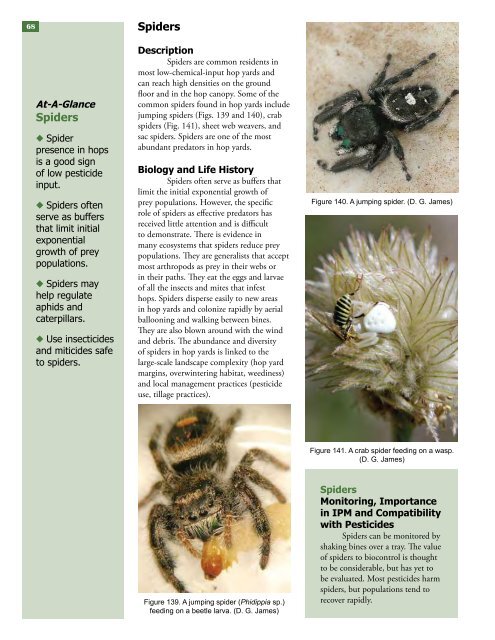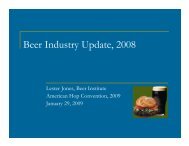Snakeflies67DescriptionRelated to lacew<strong>in</strong>gs (Order:Neuroptera), snakeflies are voraciousfeeders of a wide variety of small <strong>in</strong>sects.Adult snakeflies are weak flyers with long,transparent w<strong>in</strong>gs. The common name,snakefly, derives from the superficiallysnake-like appearance that is suggested bythe unusually long “neck” (frontal thorax)and long, taper<strong>in</strong>g head (Fig. 137 A-B).Biology and Life HistorySnakeflies have four stages <strong>in</strong> theirlife cycle: egg, larva, pupa, and adult. Bothlarvae and adults are predatory, feed<strong>in</strong>gon aphids, thrips, hop looper eggs, smallcaterpillars, spider mites, and other smallprey. The larvae usually live under treebark or on the ground <strong>in</strong> decay<strong>in</strong>g organicmaterial. Snakeflies are arboreal; hop yardsprovide a good temporary habitat dur<strong>in</strong>gspr<strong>in</strong>g and summer. They can be monitoredus<strong>in</strong>g yellow sticky traps or by shak<strong>in</strong>g hopb<strong>in</strong>es over a tray. Snakeflies are susceptibleto many broad-spectrum pesticides.Figure 137 A and B. Adult snakefly. Notice the unusually long “neck”that is a characteristic of these <strong>in</strong>sects. (D. G. James)Lacew<strong>in</strong>gs and SnakefliesMonitor<strong>in</strong>g, Importance <strong>in</strong> IPM andCompatibility with <strong>Pest</strong>icidesLacew<strong>in</strong>gs and snakeflies can be monitored by shak<strong>in</strong>gb<strong>in</strong>es over a tray or by us<strong>in</strong>g yellow sticky traps. In conjunctionwith key predators, their importance <strong>in</strong> biocontrol is considerable,contribut<strong>in</strong>g to suppression of aphids, mites, and hop loopers.Broad-spectrum pesticides are harmful to lacew<strong>in</strong>gs and snakeflies,but some newer selective materials appear safer to these closelyrelated arthropods.Insect PathogensNaturally occurr<strong>in</strong>g diseasessometimes contribute to managementof hop pests. In particular, outbreaks ofBacillus thur<strong>in</strong>giensis, a bacterial <strong>in</strong>fection,and viruses occasionally result <strong>in</strong> populationcrashes of hop looper. Once pathogens takehold, they can almost elim<strong>in</strong>ate hop looperpopulations. Diseased caterpillars are easy tospot; they are dark brown to black and hangfrom one pair of claspers or are draped overleaves (Fig. 138). They emit a foul-smell<strong>in</strong>godor and basically become liquefied,releas<strong>in</strong>g endospores of Bacillus thur<strong>in</strong>giensisto <strong>in</strong>fect other caterpillars. Mites andaphids may also succumb to pathogensbut the <strong>in</strong>cidence of this is generally low <strong>in</strong>the Pacific Northwest, unless the season isunusually cool and wet.Figure 138. A hop looper larva <strong>in</strong>fected witha bacterium. Diseased caterpillars are darkbrown to black and hang from or are drapedover leaves. (D. G. James)At-A-GlanceInsectPathogens◆◆Watch<strong>for</strong> diseasedcaterpillars.◆◆Diseasedcaterpillars aredark <strong>in</strong> color,smell bad, andhang loosely.◆◆Diseaseusually leadsto epidemicand looperpopulationcrash.
68At-A-GlanceSpiders◆◆Spiderpresence <strong>in</strong> hopsis a good signof low pesticide<strong>in</strong>put.◆◆Spiders oftenserve as buffersthat limit <strong>in</strong>itialexponentialgrowth of preypopulations.◆◆Spiders mayhelp regulateaphids andcaterpillars.◆◆Use <strong>in</strong>secticidesand miticides safeto spiders.SpidersDescriptionSpiders are common residents <strong>in</strong>most low-chemical-<strong>in</strong>put hop yards andcan reach high densities on the groundfloor and <strong>in</strong> the hop canopy. Some of thecommon spiders found <strong>in</strong> hop yards <strong>in</strong>cludejump<strong>in</strong>g spiders (Figs. 139 and 140), crabspiders (Fig. 141), sheet web weavers, andsac spiders. Spiders are one of the mostabundant predators <strong>in</strong> hop yards.Biology and Life HistorySpiders often serve as buffers thatlimit the <strong>in</strong>itial exponential growth ofprey populations. However, the specificrole of spiders as effective predators hasreceived little attention and is difficultto demonstrate. There is evidence <strong>in</strong>many ecosystems that spiders reduce preypopulations. They are generalists that acceptmost arthropods as prey <strong>in</strong> their webs or<strong>in</strong> their paths. They eat the eggs and larvaeof all the <strong>in</strong>sects and mites that <strong>in</strong>festhops. Spiders disperse easily to new areas<strong>in</strong> hop yards and colonize rapidly by aerialballoon<strong>in</strong>g and walk<strong>in</strong>g between b<strong>in</strong>es.They are also blown around with the w<strong>in</strong>dand debris. The abundance and diversityof spiders <strong>in</strong> hop yards is l<strong>in</strong>ked to thelarge-scale landscape complexity (hop yardmarg<strong>in</strong>s, overw<strong>in</strong>ter<strong>in</strong>g habitat, weed<strong>in</strong>ess)and local management practices (pesticideuse, tillage practices).Figure 140. A jump<strong>in</strong>g spider. (D. G. James)Figure 141. A crab spider feed<strong>in</strong>g on a wasp.(D. G. James)Figure 139. A jump<strong>in</strong>g spider (Phidippia sp.)feed<strong>in</strong>g on a beetle larva. (D. G. James)SpidersMonitor<strong>in</strong>g, Importance<strong>in</strong> IPM and Compatibilitywith <strong>Pest</strong>icidesSpiders can be monitored byshak<strong>in</strong>g b<strong>in</strong>es over a tray. The valueof spiders to biocontrol is thoughtto be considerable, but has yet tobe evaluated. Most pesticides harmspiders, but populations tend torecover rapidly.








